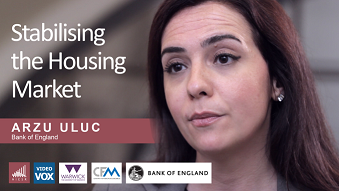Monday’s Macro Memo: Agent-Based Models and Loss Aversion in the UK Housing Market
This is my third memo featuring research presented at the conference on Applications of Behavioural Economics, and Multiple Equilibrium Models to Macroeconomics Policy Conference held at the Bank of England on July 3rd and 4th 2017.
This is my third memo featuring research presented at the conference on Applications of Behavioural Economics, and Multiple Equilibrium Models to Macroeconomics Policy Conference held at the Bank of England on July 3rd and 4th 2017.
Last week I featured two US central bankers, Jim Bullard, President of the St Louis Fed and Kevin Lansing, a Research Advisor at the Federal Reserve Bank of San Francisco. This week’s post features two papers on the housing market, presented by two researchers at the Bank of England; Arzu Uluc and Philippe Bracke. One of these papers uses an Agent Based-Modelling approach to study the effects of macroprudential policy in the housing market. The other is a large-scale empirical study which finds significant evidence against the hypothesis that we are all perfectly rational. Homo Economicus and Femina Economica display more subtle behaviour than simple neo-classical models admit.
Let’s begin with a fascinating paper co-authored by Philippe Bracke and Silvana Tenreyo. You can find a video link where Philippe discusses their research here.
Philippe is a senior economist at the Bank of England and Silvana is a Professor at the London School of Economics and she is also the latest addition to the Bank of England’s Monetary Policy Committee.
Philippe and Silvana’s paper studies history dependence in the UK housing market. They ask a simple and fascinating question. Imagine that there are two comparable houses for sale. They are both in the same neighbourhood. They are both three-bedroom semi-detached houses with two bathrooms. Both houses have a front garden and off-street parking. Both houses are five-minute’s walk from an underground station. But they differ in one important respect. House A is owned by a person who bought the house when house prices were at an all-time high. House B is owned by someone who bought it when house prices were at an all-time low. By studying a comprehensive data set of house sales in the UK, Bracke and Tenreyo find that the owner of house A will typically hold out for a higher price than the owner of house B.
That is an interesting finding because rational Femina Economica should care only about the price. History should not matter. If that was the end of the story, the paper would be an interesting contribution to the literature and would likely be published in a top journal. But Philippe and Silvana go further. They distinguish two possible explanations for history dependence.
The first explanation is that people are not rational in the sense of Femina Economica and Homo Economicus. Instead, they behave in a way that Tversky and Kahneman call loss aversion. If you are buying a house from a person who bought it a long time ago and who has made a big profit, that person will be willing to sell it for less than someone who is selling a comparable house, but is taking a loss on the sale. Bracke and Tenreyo call that anchoring.
A second possible explanation for the same observation is that the person who suffered a loss has a large mortgage and needs a higher price to move on to her next purchase. To separate those two explanations Bracke and Tenreyo separate their data into those who have large mortgages and those who own their homes outright. If the second explanation were correct, there should be no evidence of history dependence among those who are debt free. The data does not support that hypothesis. Bracke and Tenreyo find that sellers demand a higher price if they bought the house when prices were high; and the effect is uniform across those with mortgages and those without. Tversky and Kahneman studied loss aversion in experiments on human subjects. Bracke and Tenreyo find evidence that supports the loss-aversion hypothesis in real world housing data.
Now let’s turn to Arzu Uluc, who discusses her co-authored work with Rafa Baptista, Doyne Farmer, Marc Hinterschweiger, Katie Low and Daniel Tang. You can find a link to Arzu’s description of her research here.

The 2008 financial crash was not just an economic crisis; it was also a crisis for the dominant research paradigm: neo-classical economic theory. The paper that Arzu presented is an example of one of the alternative approaches to economics that have flowered as a response to a perceived failure of the neo-classical approach. Standard neo-classical economic models assume that the world is populated by rational people with infinite powers of future perception. Arzu and her co-authors use instead an agent based modelling (ABM) approach.
Agent Based Modelling draws its inspiration from the success of computer modelling techniques in the natural sciences. For the uninitiated, I recommend the Online Guide by Robert Axelrod and Leigh Tesfatsion at the University of Iowa. In an agent based model, human beings are modelled as automata that respond in predetermined ways to their environment. Agent based models are highly non-linear complex systems that can generate a wide range of endogenous propagation mechanisms. The hope is, that by designing and experimenting with new policies in these models, we may learn how to design policies that stabilize real world economies.
Arzu et al build an agent based model with four types of agents, each of which behaves in ways that mimic the behaviours of their real-world counterparts and they find that their computer model displays a rich pattern of complex dynamics. Importantly, the simulated dynamics of the model respond to policies that limit the loan to income ratio. When the market restriction is in place, the amplitude of credit cycles is diminished. This is an approach that I expect to see applied more widely in the coming years.
Before you go here is a preview of the issues I’ll tackle in my next few posts – have a listen to the clips from other speakers at the conference last July, and watch this space.
Watch both videos here:


















